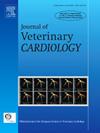Pre-operative left atrial size and functions are predictors of left atrial reverse remodelling after mitral valvuloplasty for myxomatous mitral valve disease in dogs
IF 1.5
2区 农林科学
Q2 VETERINARY SCIENCES
引用次数: 0
Abstract
Objectives
The objective of this study was to determine alterations in left atrial size, function, and determinants of left atrial reverse remodelling (LARR) after mitral valvuloplasty (MVP) in dogs with myxomatous mitral valve disease.
Animals
Thirty-seven dogs undergoing MVP were included in this study.
Materials and Methods
Echocardiographic parameters, including left atrial (LA) strain, were evaluated at baseline, during the early postoperative period (within two weeks), and at one and three months postoperatively. Patients were divided into two groups based on the attainment of LARR, defined as a left atrial-to-aortic root ratio (LA:Ao) < 1.6 at three months. The predictors of LARR were analysed using univariate logistic regression analysis.
Results
Left atrial-to-aortic root ratio significantly decreased in the early postoperative period (median: 1.68; lower and upper quartiles: 1.54–1.92) compared to that in baseline (2.41; 2.00–2.80), with a further significant reduction observed at three months (1.46; 1.34–1.63). Left atrial reverse remodelling was achieved in 27 (73%) patients. Baseline left atrial-to-aortic root ratio was higher, and peak atrial longitudinal strain and peak atrial contraction strain (PACS) were lower in the non-LARR group than in the LARR group. Among the baseline parameters, PACS was the strongest predictor of LARR (area under the curve: 0.837).
Conclusions
Following MVP, the LA size decreased in the early postoperative period and continued to decrease over three months of follow-up. A low PACS score was the most reliable predictor of inadequate LARR. Further studies are necessary to determine the relationship between LARR, prognosis, and the optimal timing for surgical intervention.
术前左心房大小和功能是二尖瓣粘瘤病二尖瓣成形术后左心房反向重构的预测因素。
目的:本研究的目的是确定二尖瓣黏液瘤病犬二尖瓣成形术(MVP)后左房大小、功能和左房反向重构(LARR)的决定因素的改变。动物:37只接受MVP治疗的狗被纳入本研究。材料和方法:在基线、术后早期(2周内)、术后1个月和3个月评估超声心动图参数,包括左心房(LA)应变。根据LARR的达到程度将患者分为两组,LARR定义为左心房与主动脉根比值(LA:Ao)。结果:术后早期左心房与主动脉根比值显著降低(中位数:1.68;下和上四分位数:1.54-1.92)与基线(2.41;2.00-2.80),在三个月时观察到进一步显著下降(1.46;1.34 - -1.63)。27例(73%)患者实现左心房反向重构。非LARR组左心房与主动脉根基线比值较高,心房纵应变峰和心房收缩应变峰(PACS)均低于LARR组。在基线参数中,PACS是LARR的最强预测因子(曲线下面积:0.837)。结论:MVP术后早期LA大小减小,并在随访3个月后继续减小。低PACS评分是LARR不足最可靠的预测指标。需要进一步的研究来确定LARR、预后和最佳手术时机之间的关系。
本文章由计算机程序翻译,如有差异,请以英文原文为准。
求助全文
约1分钟内获得全文
求助全文
来源期刊

Journal of Veterinary Cardiology
VETERINARY SCIENCES-
CiteScore
2.50
自引率
25.00%
发文量
66
审稿时长
154 days
期刊介绍:
The mission of the Journal of Veterinary Cardiology is to publish peer-reviewed reports of the highest quality that promote greater understanding of cardiovascular disease, and enhance the health and well being of animals and humans. The Journal of Veterinary Cardiology publishes original contributions involving research and clinical practice that include prospective and retrospective studies, clinical trials, epidemiology, observational studies, and advances in applied and basic research.
The Journal invites submission of original manuscripts. Specific content areas of interest include heart failure, arrhythmias, congenital heart disease, cardiovascular medicine, surgery, hypertension, health outcomes research, diagnostic imaging, interventional techniques, genetics, molecular cardiology, and cardiovascular pathology, pharmacology, and toxicology.
 求助内容:
求助内容: 应助结果提醒方式:
应助结果提醒方式:


